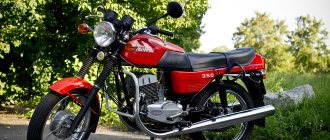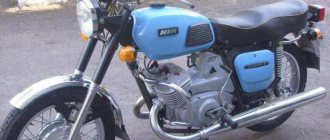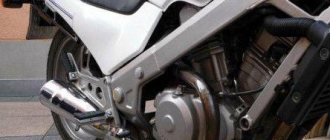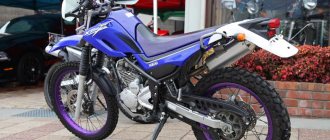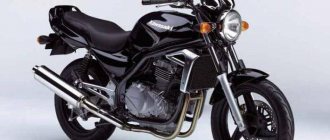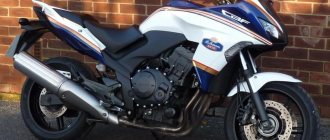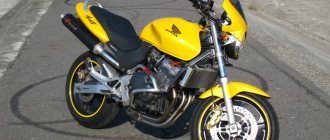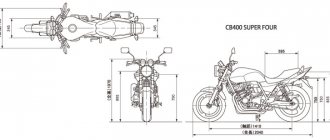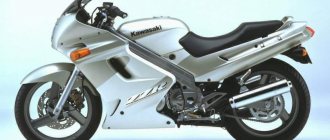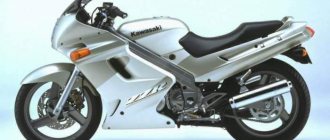RU-MOTO rating
- Reliability
- Chassis
- Appearance
- Comfort
4.3
Verdict
This motorcycle was the dream of every motorcycle enthusiast in the USSR. Reliability, beauty, speed are the key words of this motorcycle. It gained its main popularity in the 80s and 90s of the last century.
In 1929, Frantisek Janicek acquired equipment and a license for the production of motorcycles from. From the abbreviated name of the owner and the name of the company, the name of the new brand “Java” appeared.
Model history
The first model of this brand had a four-stroke engine with a capacity of 500 cm3. The motorcycle was not a success as it was heavy, unreliable and difficult to repair. The company found its element in two-stroke engines. Which were produced both single-cylinder and two-cylinder.
The company gained real momentum in the post-war years. The main exporter of popular motorcycles was the Soviet Union. Every third Soviet motorcyclist was the proud owner of a Java. The first Java 350/638 models appeared in the 80s of the last century.
Java 350/638 Lux
Java 350/638 appeared in 1985, and became a real symbol of excellence among Soviet motorcyclists. Java was head and shoulders above its Soviet counterpart, IZH Jupiter-5. And although the price was significantly higher, the motorcycle was in short supply. There were queues outside the shops to become the lucky owner of the dream.
Read other motorcycle reviews of the Honda CBR600RR: technical specifications, prices and reviews
Technical characteristics, for that time, were progressive. The two-cylinder engine produced 26 hp and was quite revvy. At that time, only IL Planet-Sport could compare with Java in dynamics, but was significantly behind in comfort. It should be mentioned that there was a “Lux” version, which had distinctive appearance features and was slightly different in the structure of the gearbox.
Motor
For the first time, cylinders on Java motorcycles began to be made of aluminum on this model. This provided a lighter design . The air cooling system has also been improved due to a unique fin arrangement.
The only thing that remained unchanged in the working system was the JAVA 638 carburetor. Otherwise, even the gas distribution changed due to improved purging and phase changes. In turn, this increased the compression ratio in the cylinders and, accordingly, the power of the unit. After boring, the cylinder now has 4 exhaust ports instead of two. This solution made it possible to create additional pressure on the crankshaft.
The YAVA 638 motorcycle, the technical characteristics of which significantly exceeded earlier models, was improved not only in the mechanical part. Improved electrical equipment made it possible to double the network voltage. The basis for this change was an asynchronous type generator. Its power was increased by changing the current to alternating current.
Price for Java 350/638
10 years ago, the Java 350/638 model was discontinued, but continues to be popular among Russian motorcyclists. Prices for used motorcycles range on average from 14,000 to 35,000 rubles. A 1988 model can be purchased for $322, a 1991 motorcycle for $1,500.
Screenshot of prices from the avito service
Screenshot of the price of a Java 350/638 motorcycle from the moto.auto.ru service
Specifications
Maximum power – 26 hp. The working volume of the two-stroke engine is 343 cubic meters. cm. It has a simplified mechanism for distributing the fuel mixture. 4 gears provide a smooth ride and synchronized transition to increasing speed.
This model is stable on bad roads. The maximum speed indicated in the passport is 120 km/h (in fact, the motorcycle can accelerate to 130 km/h). Fuel consumption is 6-7 liters per 100 km.
Read other motorcycle reviews Review of the Kawasaki ZZR 400 motorcycle
| Type by purpose | classic motorcycle |
| Number of cylinders | 2 |
| Number of cycles | 2 |
| Cooling system | cooling by incoming air flow |
| Cylinder diameter, mm | 58 |
| Piston stroke, mm | 65 |
| Engine displacement, cubic meters cm | 343,5 |
| Maximum engine power, hp | 27 |
| Maximum engine power, kW | 18 (at rpm 5500) |
| Maximum torque, H*m | 32 (at rpm 4750) |
| Diffuser diameter, mm | 1x28 |
| Number of gears | 4 |
| type of drive | on the rear wheel with a chain |
| Front wheel | 3,25 |
| Rear wheel | 3,5 |
| Front wheel suspension type | conventional telescopic fork |
| Rear wheel suspension type | pendulum with two shock absorbers |
| Front wheel brake type | drum |
| Rear wheel brake type | drum |
| Base, mm | 1370 |
| Seat height, mm | 820 |
| Dry weight, kg. | 149 |
| Maximum speed km/h | 125 (written in the manual) |
| Gas tank volume, l | 17 |
When normal people want a motorcycle, what do they usually do? They save money and buy a good Japanese/Italian/German - whoever is closer. Well, or, as a budget option, the new Chinese. On credit. Sasha never looked for easy ways in this life, and therefore in 2008 she bought herself a java. And with it, in addition, I acquired a bunch of problems, which, in fact, I wanted to share. Actually, about Java: an ordinary Jawa 350 12V “two-piece”, bought in the village for pennies. Metallic grey. 1992 release. Of course, not on the go, with the very popular collective farm tuning in the form of a “bulky” “ass”. Decent facings, but who knows what’s in the engine. The advantage was the availability of NORMAL documents and a decent 18″ Dunlop rear tire.
this is what it looked like after assembly
My husband, Kolich, had the dubious fortune of capitalizing on it. Before this, I had never had a chance to repair it. Fortunately, there were enough additional spare parts - a lot of spare parts. Oh, how many people said: you won’t assemble it, and if you do, the box won’t work! We've heard enough "bad advice" all over the Netherlands. By the way, during the capitalization process, Kolich was most outraged by the fact that the bearing landed “hot”. But his mother was very surprised: “Are you baking a pie?” Oh, good thing she didn’t see that pie! We would get lyuli for the guts of java in the oven. Already during operation, Kolich changed the ignition system to a contactless one. They also put a Yamaha fz250 front on it. Showa fork, two disc brakes, clip-ons. I liked it - the brakes appeared!
trip to Golubitskaya
In general, Kolić brought to mind this victim of the Soviet motorcycle industry. We got insurance. We started driving. When he, when I, but more often together. We had a good ride around the edge then. For Java. 12 thousand in 2 or 3 months. We rode regularly in Tuapse and went to Taman 2009. We went to Sochi once - I had an urge to drink beer there. It’s probably stupid to go to Sochi just to sit and drink beer for 40 minutes.
Java in almost Sochi
Kolic in Java on the coast
In Krasnodar, we overheated it in a traffic jam (there was no need to pour M8), it boiled, poor thing... After that, the hemorrhoids actually began. She started to get really excited. I had to pull the kick 10 times on the choke, plugging the carburetor with my hand. Standard measures did not help. Then it stopped starting altogether. I had to chop it and bake it in the oven again. It seemed to help - at least it started to start. Then we went to Labinsk to visit our comrades - 8 km from home, the semi-automatic broke down and the 4th gear fork burned out. We don’t like to return, so in the field, “on our knees”, Kolich gets the gearbox into working order and without 4th gear we drive a total of 200 km. Speed 70-90 km/h. Tolerable. At home I stabbed again - changed the fork and the link - it was bent. In total, in 2009 and 2010, Kolich injected her approximately 5 times. First we made a mistake on the central support - there is no type of compression due to the fact that the mixture is driven from one half to the other. We were already planning to buy a new one... And then we bought a Honda vt250f, and abandoned the old toy in the garage. After a while, VTZ appeared, and again there was no time for reality...
Java rode to Guzeripl
Taman. The same front end from the Yamaha Phaser 250
And this spring we decided to bring the cripple to life and sell it. The first attempt to get it moving was unsuccessful - the engine worked lousy and at one point it banged and tore the mufflers. The second attempt was successful - replacing the carburetor had a beneficial effect (I didn’t even have to change the support). Kolich painted the chassis and everything that was peeling matte black, bought new accordions... In general, Java is now really pleasing. All that remains is to paint the cladding and finish the little things. I remembered things from long ago and now I’m riding on it. It starts, as they say, “with a kick.”
They wanted to sell, but no one wanted to take it 
Kolic was skating, and I thought I was a photographer
I rode it around the collective farm right after the overhaul
What I learned for myself as a driver: it drives poorly, breaks often, oil is everywhere - the frame, mufflers, the wheel, the pendulum, the engine, my back (!!!)... They say the box is very delicate - I didn’t notice. Although the forks are thin, there was only one problem with the box. There are practically no brakes. Too weak. The clutch also showed off something periodically. The original front fork is a different story altogether! When braking, the feathers went into the glasses, jammed safely, and the fork categorically refused to work. And the acceleration of the Java is like that of Kolya’s scooter: 180cc. And they say: Java is rushing, Java is rushing... And this viper constantly lost the rear right passenger step! It was unscrewed due to vibration. And the plugs at the ends of the mufflers regularly flew out. were also unwinding. Although, to be honest, somehow I became attached to this monster with my soul - we went through so much with her. It's a shame to sell. Moreover, most of her problems were solved by Kolich, as, I’m not afraid to say, a professional mechanic. An adult is unlikely to buy it, unless he is a fan, and the stupid kids will get away with it in a week or two. I would like to hand it over to good, caring hands...
Yes, Java is outdated, both externally and internally. And they can’t compete even with those Chinese, it seems to me, but they also had and will have their fans, who will not be too bothered by the fact of fairly frequent repairs. Like this.
And they can’t compete even with those Chinese, it seems to me, but they also had and will have their fans, who will not be too bothered by the fact of fairly frequent repairs. Like this.
PS I wrote a blog, and after that the java was registered and went to Abkhazia.
Idk, somewhere along the road to Ritsa.
and even a minor crack in the tube tire didn’t hurt. Although she made me nervous all the way.
During those approximately 2000 km, 3 cables were broken: speedometer, clutch and gas. There are almost no complaints about the engine, except that instead of a high-speed star it was worth installing a traction one. Java did not disappoint! The Japanese, of course, rule, I don’t argue, but after this, to those who say: scoops are shit, I will answer: take your Honda Dio to the ferrous metal! Yes, I'm evil!
But I was on Ritsa 
Tuning examples
Over the many years of its existence, the motorcycle has seen a huge number of tuning variations. All this is due to the low abundance of technology in the Soviet Union, so in order to stand out, you had to use your imagination. One of the most popular options for tuning the appearance was raising the tail of the motorcycle, which was a reference to the Japanese models of that time. Also, the front fender was often clipped. The steering wheel was converted to sports clip-ons.
As for engine tuning, the two-stroke engine has great potential for this. But refining the engine is a much more complicated procedure and requires special skills. The engine power could be increased as follows:
- installation of a resonator;
- installation of two carburetors;
- increasing the compression ratio by reducing the volume of the combustion chamber;
- cutting vent windows;
- liquid cooling installation;
- installation of a reed valve.
Exhaust pipe tuning
Appearance tuning
Appearance tuning
Performance
YAVA 638, whose characteristics fully met the requirements necessary for the working class, received a number of innovations. One of these was the front wheel fork. It is an analogue of the ChZ-472 motorcycle. The similarity lies in the improved density of the rods and the dimensions of the supporting pipes. This system allows you to achieve the necessary rigidity and get rid of unnecessary vibrations while driving.
Increased spring tension on the shock absorber reduces vibrations transmitted to the front of the unit and the rear wheel sprocket. This innovation increases the gear ratio, which makes work easier when a trailer is installed. Actually, this is why the bike has a stable left footrest and no crash bars.
Owner reviews
Review #1
Review #2
Review #3
Review #4
Read other motorcycle reviews Moped Alpha: price, photo and video review
